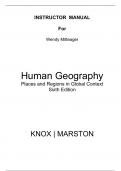INSTRUCTOR MANUAL
For
Wendy Mitteager
Human Geography
Places and Regions in Global Context
Sixth Edition
KNOX | MARSTON
, Chapter 1: Geography Matters
Overview
After reading this chapter, students should learn that geography is complex,
dynamic, and essential for understanding interdependent global relationships. The
chapter introduces important concepts that build the framework of the discipline.
Students will learn about the increasing geographic interdependence of the
world, and the importance of instant global communications and rapidly changing
international relationships. Learning about human geographies will illustrate to
students how understanding complex interrelationships are crucial to solving
problems on scales from local to global.
In addition, students will learn about geographic tools used to better
understand places such as map projections, GIS, spatial analysis, and regional
analysis. Finally, students will learn that human geography is important both from
an intellectual view and a practical point of view. Geographers study the uniqueness
of specific places while recognizing the broader processes that contribute to
economic, social, and cultural phenomena.
Learning Outcomes
1. The study of geography is essential for understanding a world that is more
complex, interdependent, and changing faster than ever before
2. How places influence inhabitants’ lives
3. Distinguish the differences between map projections and describe their
relative strengths and weaknesses
4. Explain Geographic Information Systems (GIS) and how it is used to merge
and analyze data
5. Summarize the concepts key to spatial and regional analysis and describe
how they are used to analyze relationships between people and places
6. Describe the importance of distance in shaping human activity
Chapter Outline
Geography Matters. Places Matter. (p.4)
• Geographic literacy
• Places are dynamic and complex
• Spatial organization of human activities
• How and why relationships are important
• Different geographic scales of analysis
1
Copyright © 2013 Pearson Education, Inc.
,Geographic Methods and Tools (p.7)
• Qualitative and quantitative data
• Remote sensing, maps, and GIS
• Map projections
Spatial and Regional Analysis (p.18, p.24)
• Five key concepts of spatial analysis
• Three key concepts of regional analysis
• Developing a geographical imagination
Future Geographies (p.30)
• Future patterns and pathways of change
1.1 Geography Matters – Geographers at Work (p.8)
What geographers do, and jobs and careers in geography
1.2 Visualizing Geography – Geography and Consumer Preferences (p.16)
Using geodemographic data to analyze consumer groups
1.3 Window on the World – South Beach, Miami Beach (p.28)
Successive waves of development and change
Discussion Topics and Lecture Themes
1. Discuss with the students the September 2010 strike in Maputo,
Mozambique. Ask them to discuss why the workers were striking and the
level of poverty that exists. Then ask the students to discuss the role of
current technology on the strike and how this relates to other movements in
the past or present. Note that this strike is a reflection of the increasing
geographic interdependence of the world.
a. This former Portuguese colony is ranked 175th out of 179 countries on
the UN Human Development Index. Population below poverty
line=70%; Population unemployed=54%; Annual per capita
income=$807
b. Price increase in bread by 30% prompted the riots and strikes.
c. The riots and strikes were organized primarily by text messaging.
You can relate this to past movements which did not have current
technology, and current movements—such as the Occupy Wall Street
movement—which relies heavily on technology as a means of
organizing.
2
Copyright © 2013 Pearson Education, Inc.
, d. Rising food prices in Mozambique is partly the result of: increasing
food consumption in other parts of the world, increasing meat
consumption which drives up the price of grain, increasing energy
prices, and climate change.
2. Apply Your Knowledge: List three reasons why a corporate employer would
feel it is important for prospective employees to have some knowledge of
geography.
a. By obtaining a better understanding of the world, people can
overcome closed-mindedness, prejudice, and discrimination.
b. As the world becomes more interdependent, workers will have to
communicate with other cultures and understanding the diversity of
this world can help with communications and transactions.
c. Economic and political structures are operating on global scales.
3. Ask students to examine their own Geographic Literacy. Can they find their
own country on a world map? How about locating Washington D.C. or
Yellowstone National Park on a blank map of the U.S.? Ask them to locate the
nations or cities in which recent natural disasters, uprisings, or battles/wars
have occurred. Have them point the locations out on a world map. Ask them
what the most common native spoken language is in the world (Mandarin
Chinese).
a. Ask them to point out what region and specific locations Hurricane
Irene greatly impacted such as the Schoharie River Valley in New York
State or the Connecticut River Valley in Vermont.
b. Ask them to point out the location of Iraq, Afghanistan, and Egypt.
4. Ask the students what they ate and drank for breakfast. Then ask them to
state the likely origins for these foods and beverages (Ecuadorian bananas,
Brazilian coffee, Florida oranges, etc.). How do the local community and the
source regions for these products depend on each other?
a. The local community needs to import items that cannot be produced
locally, whereas source regions depend on external communities for
markets.
5. Have students draw maps of their hometowns (or the local area). Have them
include emotional and cultural symbols, ordinary places with special
meanings (e.g., childhood neighborhoods), and points or paths of
accessibility (airports, major highways, etc). Then have the students compare
the maps. What are common elements of all maps? What did the students
identify as important? How detailed are their maps? Does detail reflect
familiarity?
3
Copyright © 2013 Pearson Education, Inc.




